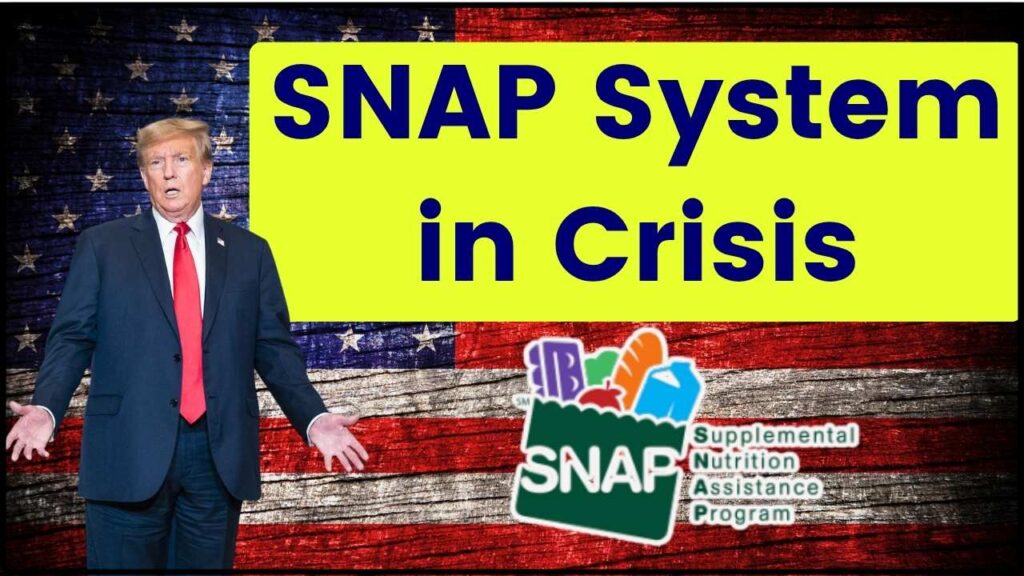SNAP System in Crisis: The Supplemental Nutrition Assistance Program, better known as SNAP, has landed in hot water. Recent reports uncovered a jaw-dropping issue: around 186,000 deceased individuals are still receiving SNAP benefits across multiple states. This revelation has launched USDA officials into action, mandating that every SNAP recipient must reapply to confirm they are truly eligible for assistance. If SNAP plays a role in your life or work, knowing the full story behind this crisis—and what’s coming next—is key. This article breaks down everything from the basics of SNAP to detailed steps for the upcoming reapplication process, with handy tips and reliable info to keep you ahead of the curve.
SNAP System in Crisis
The discovery that 186,000 deceased individuals were receiving SNAP benefits has exposed a major flaw within this crucial program. In response, the USDA’s mandate for nationwide reapplication represents a historic effort to clean up fraud, protect federal funds, and ensure that SNAP continues to serve those who truly need it. Whether you’re a beneficiary, a caseworker, or someone interested in social policy, understanding these changes is essential. Stay informed, prepare your documents, and reach out for help if needed to navigate this transition smoothly. The road ahead promises reforms but also challenges. Together, with knowledge and action, we can help preserve this vital safety net for millions.

| Topic | Details |
|---|---|
| Number of Deceased Recipients | 186,000 dead individuals still receiving SNAP benefits, based on data from 29 states |
| Total SNAP Recipients | Nearly 42 million Americans rely on SNAP |
| Program Cost | Approximately $100 billion in fiscal year 2024 |
| USDA Plan | Nationwide reapplication required for all current SNAP participants |
| Legislation Impact | The “One Big Beautiful Bill” cut $186 billion from SNAP funding and increased work requirements |
| Fraud Investigation | 17,000 illegal transactions uncovered; 120 arrests made during investigations |
| Official Information | USDA SNAP Program |
What Is SNAP and Why Does It Matter?
SNAP is the backbone of nutrition support for millions of Americans facing financial hardships. It provides a monthly allotment through an electronic benefits transfer (EBT) card, helping families, seniors, and individuals put groceries on the table. The stakes are huge: in 2024, SNAP served nearly 42 million people nationwide with a budget of around $100 billion. Because it operates on taxpayer dollars, protecting program integrity is crucial—not just to prevent waste, but to keep funds flowing to the people who really need them.
A Brief History of SNAP System in Crisis: From Food Stamps to Today
Understanding the current crisis means knowing where SNAP came from. The program traces its roots back to the Great Depression, when widespread unemployment and hunger prompted early food relief efforts.
- 1939: The first Food Stamp Program launched as a pilot in Rochester, New York, aiming to support struggling families and reduce surplus farm goods.
- 1961-1964: Pilot programs tested improved models of food assistance that did not require purchasing stamps.
- 1964: The Food Stamp Act made the program permanent, coinciding with President Lyndon B. Johnson’s War on Poverty.
- 1970s-1990s: SNAP expanded nationwide, with legislative reforms aimed at tightening eligibility and improving benefit delivery.
- 2004 and later: The adoption of Electronic Benefit Transfer (EBT) cards replaced paper coupons, modernizing the program and streamlining access.
- 2020s: SNAP remains the nation’s largest food aid program, adapting to economic changes, natural disasters, and now fraud challenges.
This rich history reflects SNAP’s evolving role as a cornerstone of social safety nets in the U.S.

The Roots of the Current Crisis: How Did Dead People Get on SNAP?
This isn’t just a clerical slip-up—it’s a sign of deeper issues. The USDA, led by Secretary Brooke Rollins, launched a lengthy investigation and found that many records hadn’t been updated to remove deceased participants. The 186,000 figure emerged from data across 29 states, many run by Republican governments.
Instances of fraud uncovered include:
- Multiple benefits under one Social Security number, sometimes in different states.
- False identities used to collect payments.
- Cases where illegal immigrants or convicted criminals were receiving aid.
- Widespread use of SNAP benefits in unauthorized ways.
The USDA investigation involved an aggressive crackdown, with 120 arrests made and millions of dollars in fraudulent payments blocked.
Such issues reveal vulnerabilities in how data is maintained, cross-checked, and updated between federal and state systems.

What Is the USDA Doing to Fix SNAP System in Crisis?
The biggest change: all current SNAP participants must reapply for benefits. This will clear out fraudulent accounts and update records. The USDA says this is necessary to close loopholes and preserve funding integrity.
Officials are working with states to carry out this mammoth task, but no detailed timelines have been shared yet. This uncertainty worries many recipients and state agencies about potential disruptions.
Reapplication will require submitting updated proof of income, household composition, citizenship status, and identification.
The Legislative Backdrop: Explaining the “One Big Beautiful Bill”
Congress recently enacted the “One Big Beautiful Bill”, which cut $186 billion from SNAP funding. It also introduced stricter work requirements for able-bodied adults without dependents. This bill is a major part of SNAP’s ongoing transformation and has sparked heated debates over food security versus fraud control.
Critics highlight that cuts and hurdles may increase food insecurity for vulnerable populations, while proponents argue the bill prevents abuse and encourages employment.
Impact of SNAP System in Crisis on Families and Communities
SNAP is more than just an aid program—it’s a social safety net that millions depend on. The possibility of benefit disruptions due to reapplication could leave some families scrambling, especially in areas with fewer social services.
For rural communities and Native American reservations, where food insecurity is often higher, the stakes are especially high. Advocates warn that if the process isn’t handled carefully, genuinely eligible people might lose access when they need help most.
Children, seniors, and disabled individuals—groups vulnerable to hunger’s health impacts—are at particular risk if program access is disrupted.
Technology and Fraud Detection: Modern Tools Being Used
To tackle fraud, the USDA is ramping up use of data analysis, identity verification technology, and cross-state systems. AI and machine learning tools help identify suspicious activity by flagging:
- Dual claims with the same SSN.
- Patterns of rapid changes in benefit amounts.
- Transactions outside authorized locations.
These tools aim to balance fraud reduction with minimizing harm to legitimate beneficiaries.
Despite advances, challenges remain in integrating databases across agencies, updating records promptly when recipients die or move, and effectively catching newer types of fraud.
How to Prepare for the SNAP Reapplication?
Here’s a practical guide:
- Stay Updated: Check your mailbox, email, and official state SNAP websites often for updates on when to reapply.
- Gather Documentation: Collect pay stubs, social security cards, lease agreements, and any documents proving income or changes in your household.
- Be Timely: Submit your reapplication promptly to avoid missed payments.
- Ask for Help: Use local food banks, community centers, and legal aid if you face difficulties. Some organizations provide assistance with SNAP paperwork.
- Monitor Your Account: Keep an eye on your EBT account for any unusual activity or notifications.
Community Support and Advocacy
As SNAP faces these changes, community support is crucial. Here are ways you can help:
- Spread Awareness: Inform your community about upcoming reapplication requirements.
- Volunteer Assistance: Help with paperwork and outreach through local organizations.
- Promote Policy Dialogue: Engage with lawmakers to ensure reforms protect those in real need.
- Support Anti-Hunger Groups: Donate or volunteer with Feeding America or similar entities to support food-insecure families.
Government Shutdown Over; But When Will Your CalFresh SNAP Benefits Actually Arrive?
Federal Government Reopens; Here’s What SNAP, IRS, TSA & Federal Workers Can Expect Now
New SNAP Rules Take Effect This Month; Millions Could See Their Eligibility Vanish








